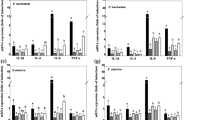Abstract
The activities and modes of probiotic action of lactic acid bacteria isolated from infant feces were investigated for alternative application in the prevention and biotherapy of colon cancer. From a total of 81 isolates of Gram-positive rod and cocci bacteria obtained from healthy infants, only 15 isolates had the probiotic criteria which included growth inhibition against eight food-borne pathogens, no blood hemolysis, and tolerance to gastrointestinal tract properties such as pH 2.5 and 0.3 % bile salt. Four probiotic bacteria showed antiproliferation of colon cancer cells with the use of MTT and Trypan blue exclusion assay at the rates of 17–35 %. Through comparison of probiotic 16S rRNA sequences, they were identified as Pediococcus pentosaceus FP3, Lactobacillus salivarius FP25, L. salivarius FP35, and Enterococcus faecium FP51. Finding the mechanism of proliferative inhibition of colon cancer cells in this study indicated synergic induction by probiotic bacteria directly adhered to these cancer cells and triggered the bioproduction of short-chain fatty acids, mainly butyric and propionic acids. This study suggested that the use of these probiotics may be suitable as an alternative bioprophylactic and biotherapeutic strategy for colon cancer.







Similar content being viewed by others
References
Bäckhed, F., Ley, R. E., Sonnenburg, J. L., Peterson, D. A., & Gordon, J. I. (2005). Science, 307, 1915–1920.
McFall-Ngai, M. (2007). Nature, 445, 153.
O’Flaherty, S., & Klaenhammer, T. R. (2010). International Dairy Journal, 20, 262–268.
Thirabunyanon, M. (2011). Maejo International Journal of Science and Technology, 5, 108–128.
Thirabunyanon, M., & Thongwittaya, Ν. (2012). Research in Veterinary Science, 93, 74–81.
McBain, A. J., & Macfarlane, G. T. (1998). Journal of Medical Microbiology, 47, 407–416.
Rafter, J. (2003). Best Practice & Research Clinical Gastroenterology, 17, 849–859.
Travaglione, S., Fabbri, A., & Fiorentini, C. (2008). Infectious Agents and Cancer., 3, 4.
Commane, D., Hughes, R., Shortt, C., & Rowland, I. (2005). Mutation Research, 591, 276–289.
Ohkawara, S., Furuya, H., Nagashima, K., Asanuma, N., & Hino, T. (2005). The Journal of Nutrition, 135, 2878–8283.
Ma, E. L., Choi, Y. J., Choi, J., Pothoulakis, C., Rhee, S. H., & Im, E. (2010). International Journal of Cancer, 127, 780–790.
Thirabunyanon, M., Boonprasom, P., & Niamsup, P. (2009). Biotechnology Letters, 31, 571–576.
Millette, M., Dupont, C., Shareck, F., Ruiz, M. T., Archambault, D., & Lacroix, M. (2008). Journal of Applied Microbiology, 104, 269–275.
Pridmore, R. D., Pittet, A. C., Praplan, F., & Cavadini, C. (2008). FEMS Microbiology Letters, 283, 210–215.
Verdenelli, M. C., Ghelfi, F., Silvi, S., Orpianesi, C., Cecchini, C., & Cresci, A. (2009). European Journal of Nutrition, 48, 355–363.
Gaudana, S. B., Dhanani, A. S., & Bagchi, T. (2010). British Journal of Nutrition, 103, 1620–1628.
Pennacchia, C., Ercolini, D., Blaiotta, G., Pepe, O., Mauriello, G., & Villani, F. (2004). Meat Science, 67, 309–317.
Ewaschuk, J. B., Walker, J. W., Diaz, H., & Madsen, K. L. (2006). Journal of Nutrition, 136, 1483–1487.
Lee, N. K., Park, J. S., Park, E., & Paik, H. D. (2007). Letters in Applied Microbiology, 44, 274–278.
Hussain, M. A., Rouch, D. A., & Britz, M. L. (2009). International Dairy Journal, 19, 12–21.
Jan, G., Belzacq, A. S., Haouzi, D., Rouault, A., Métivier, D., Kroemer, G., & Brenner, C. (2002). Cell Death and Differentiation, 9, 179–188.
Shmuely, H., Passaro, D., Figer, A., Niv, Y., Pitlik, S., Samra, Z., Koren, R., & Yahav, J. (2001). The American Journal of Gastroenterology, 96, 3406–3410.
Maragkoudakis, P. A., Mountzouris, K. C., Psyrras, D., Cremonese, S., Fischer, J., Cantor, M. D., & Tsakalidou, E. (2009). International Journal of Food Microbiology, 130, 219–226.
Zoumpopoulou, G., Foligne, B., Christodoulou, K., Grangette, C., Pot, B., & Tsakalidou, E. (2008). International Journal of Food Microbiology, 121, 18–26.
Fotiadis, C. I., Stoidis, C. N., Spyropoulos, B. G., & Zografos, E. D. (2008). World Journal of Gastroenterology, 14, 6453–6457.
Salmeron, I., Fuciños, P., Charalampopoulos, D., & Pandiella, S. S. (2009). Food Chemistry, 117, 265–271.
Acknowledgments
This research was financially supported by the National Research Council of Thailand.
Author information
Authors and Affiliations
Corresponding author
Rights and permissions
About this article
Cite this article
Thirabunyanon, M., Hongwittayakorn, P. Potential Probiotic Lactic Acid Bacteria of Human Origin Induce Antiproliferation of Colon Cancer Cells via Synergic Actions in Adhesion to Cancer Cells and Short-Chain Fatty Acid Bioproduction. Appl Biochem Biotechnol 169, 511–525 (2013). https://doi.org/10.1007/s12010-012-9995-y
Received:
Accepted:
Published:
Issue Date:
DOI: https://doi.org/10.1007/s12010-012-9995-y




